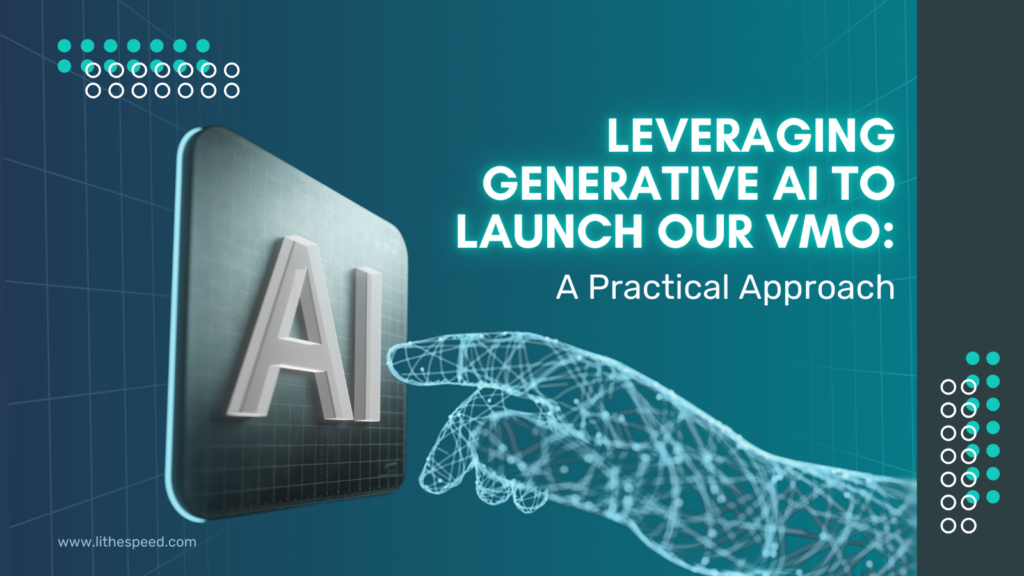As organizations embrace business agility, establishing a Value Management Office (VMO) has become essential for aligning strategy with execution. The VMO serves as a critical leadership construct that enables lean portfolio management and adaptive governance. However, launching a VMO presents unique challenges that require specialized knowledge and significant resources.
For many organizations starting the journey from PMO to VMO, knowing where and how to start can be both the first and final obstacle. I’ve found that, when used thoughtfully, Generative AI tools can help move us past that first obstacle. And from that point, any subsequent ones in our path to launching our Agile Value Management Office (VMO).
The VMO Implementation Challenge
Launching a VMO is challenging because it requires expertise in multiple domains. Most organizations struggle with the transition from project-centric to value-stream operating models. This shift demands comprehensive changes to processes, roles, and organizational mindsets. Additionally, specialized knowledge in areas like WSJF prioritization, OKRs, value stream mapping, and change management is rarely concentrated in a single team.
Resource constraints further complicate matters. Even if we have skilled practitioners, they’re often already occupied with critical operational tasks. This leaves strategic initiatives like stakeholder alignment or metrics design under-resourced. When combined with natural resistance to change, these factors can significantly delay or derail VMO implementations.
How GenAI Can Support Our VMO Launch
Generative AI serves as a powerful ally in addressing these challenges by amplifying existing expertise and enabling teams to focus on strategic decision-making rather than administrative tasks.
Expertise Amplification
GenAI doesn’t replace human judgment, but provides on-demand knowledge in areas where our team might lack specialized expertise. For example, when mapping value streams, GenAI can analyze process data to identify bottlenecks and suggest targeted improvements. This capability particularly helps teams new to lean thinking who might otherwise miss critical optimization opportunities.
Resource Optimization
The early days of a VMO typically involve numerous time-consuming tasks like stakeholder analysis, communication planning, and metric definition. GenAI can automate many of these activities, allowing our team to focus on building relationships and strategic alignment instead of documentation.
Cross-functional Alignment
A successful VMO requires alignment across departments with different priorities, ways of working and associated communication standards. This can be a challenge for the most skilled of teams, and is effortful and time consuming if done well.
GenAI excels at tailoring communication to specific stakeholders and facilitating shared understanding. For instance, it can translate technical constraints for business stakeholders or explain market demands to technical teams, creating a common ground for collaborative decision-making.
A 90-Day Approach to GenAI-Supported VMO Implementation
As we like to often say when discussing using the Kanban method, “stop starting and start finishing”. This principle in practice also applies to launching our VMO. We want to have a thoughtful and viable 90 day plan with concrete steps to get our VMO up and running. The three phases below are a good way for those of us who are overwhelmed with where to start and what to do to have a simple, AI-enabled list:
Foundation Setting (Days 1-30)
During the initial phase, we focus on stakeholder engagement and vision development. We use GenAI to analyze our organizational structure and identify key stakeholders across departments. We generate tailored communication plans that address specific concerns for each group.
When defining our VMO’s vision, GenAI helps translate strategic goals into measurable objectives and key results. This ensures alignment between organizational priorities and VMO activities from the start.
Implementation (Days 31-60)
The second phase involves assembling our team and establishing core processes. GenAI can analyze skill requirements and recommend training or development paths to address gaps. For governance framework design, we use GenAI to draft adaptive policies that balance agility with compliance requirements specific to our industry.
Implementing WSJF prioritization becomes more efficient with GenAI calculating scores and visualizing priorities across our portfolio. This removes much of the subjectivity and political maneuvering that often derails early prioritization efforts.
Optimization (Days 61-90)
As we begin tracking value delivery, GenAI can help us develop dashboards that visualize performance metrics like cycle time, throughput, and customer satisfaction. These real-time insights help demonstrate the VMO’s impact to stakeholders.
For continuous improvement, we can use GenAI to analyze retrospective data and identify patterns that might not be immediately apparent to the team. This leads to more targeted improvements in both the VMO’s operations and the value streams it supports.
Finding the Right Balance
While GenAI offers significant advantages, it’s important to use it thoughtfully and with a clear understanding of its inherent weaknesses and potential risks in poorly managed use.
Regardless of GenAI solution, the overall technology works best when complementing human expertise rather than replacing it. Critical thinking and analysis remains essential when evaluating GenAI outputs, particularly for context-specific recommendations.
We must ensure that, as we leverage these tools to help accelerate and improve the launch of our Agile VMO, that we are always thoughtful about their limitations, and the common issue of their being “confident but wrong” in cases. All of us have read or seen at least a few embarrassing instances where these technologies have failed in dramatic fashion, and we certainly must proactively ensure that we don’t become the next example.
Moving Forward
The integration of GenAI in VMO launches represents a significant opportunity to enhance efficiency, alignment, and value delivery in an accelerated way.
By automating routine tasks, performing analysis of data to suggest areas of focus or providing specialized knowledge on demand, GenAI allows our teams to focus on the strategic and interpersonal aspects of change that truly require human judgment, collaboration and context-specific pragmatism.
As we continue to explore the intersection of AI and business agility, the focus should remain on leveraging these tools to create meaningful outcomes—not simply showcasing technological capabilities. When used effectively, GenAI can help us – more quickly and efficiently and comprehensively – establish a VMO that drives true value for our organizations.
Watch Part 1: https://youtu.be/k_geAaq7SoY?si=fEqn5qr_WAOYgEA-
RSVP for Part 2: https://www.meetup.com/dc-lean-agile/events/306920568/
RSVP for Part 3: https://www.meetup.com/dc-lean-agile/events/306921149/

